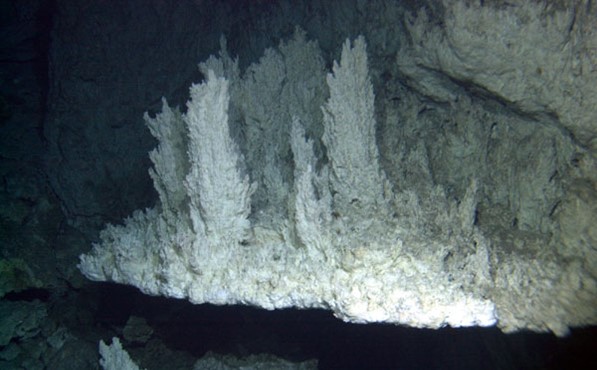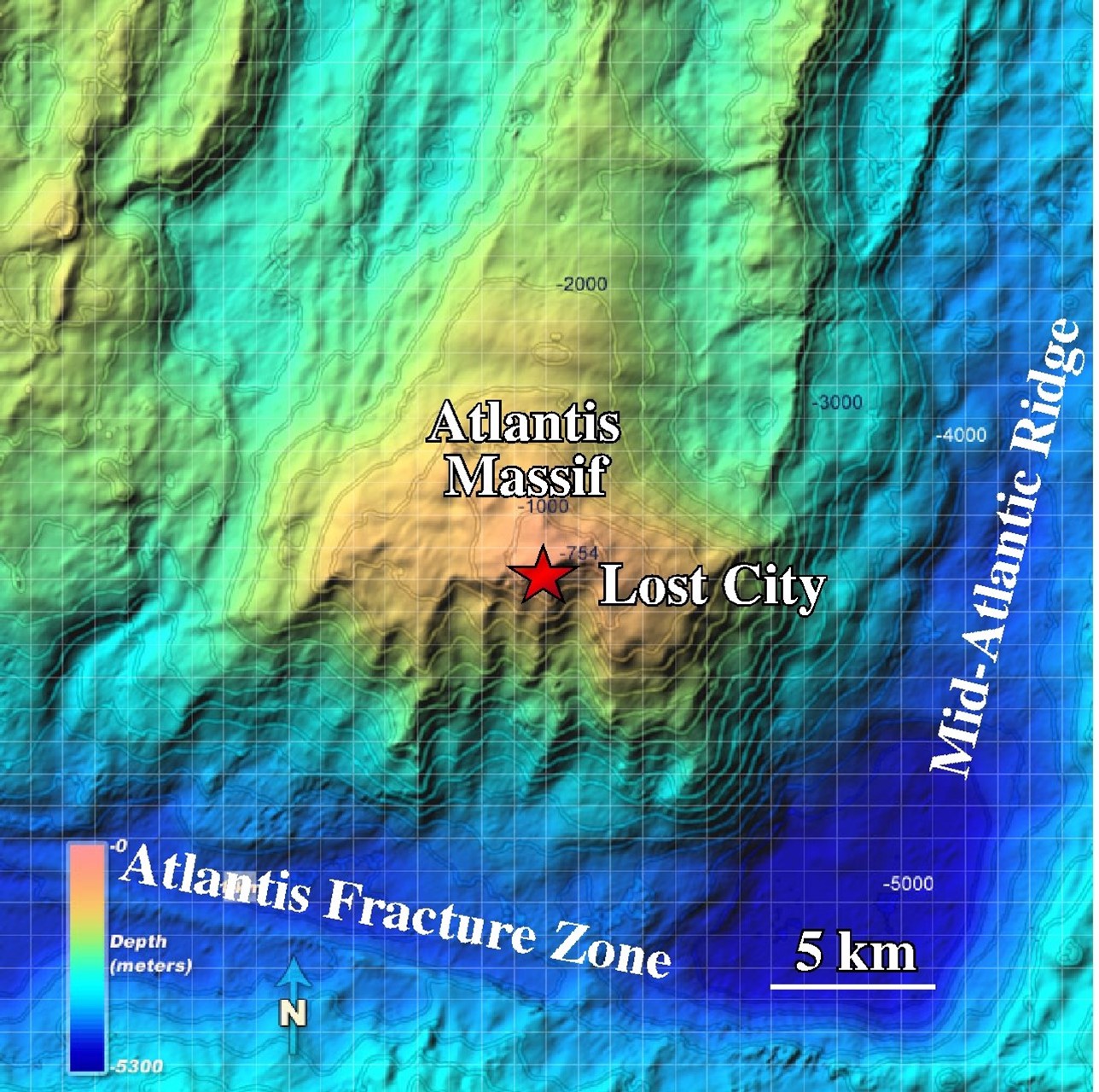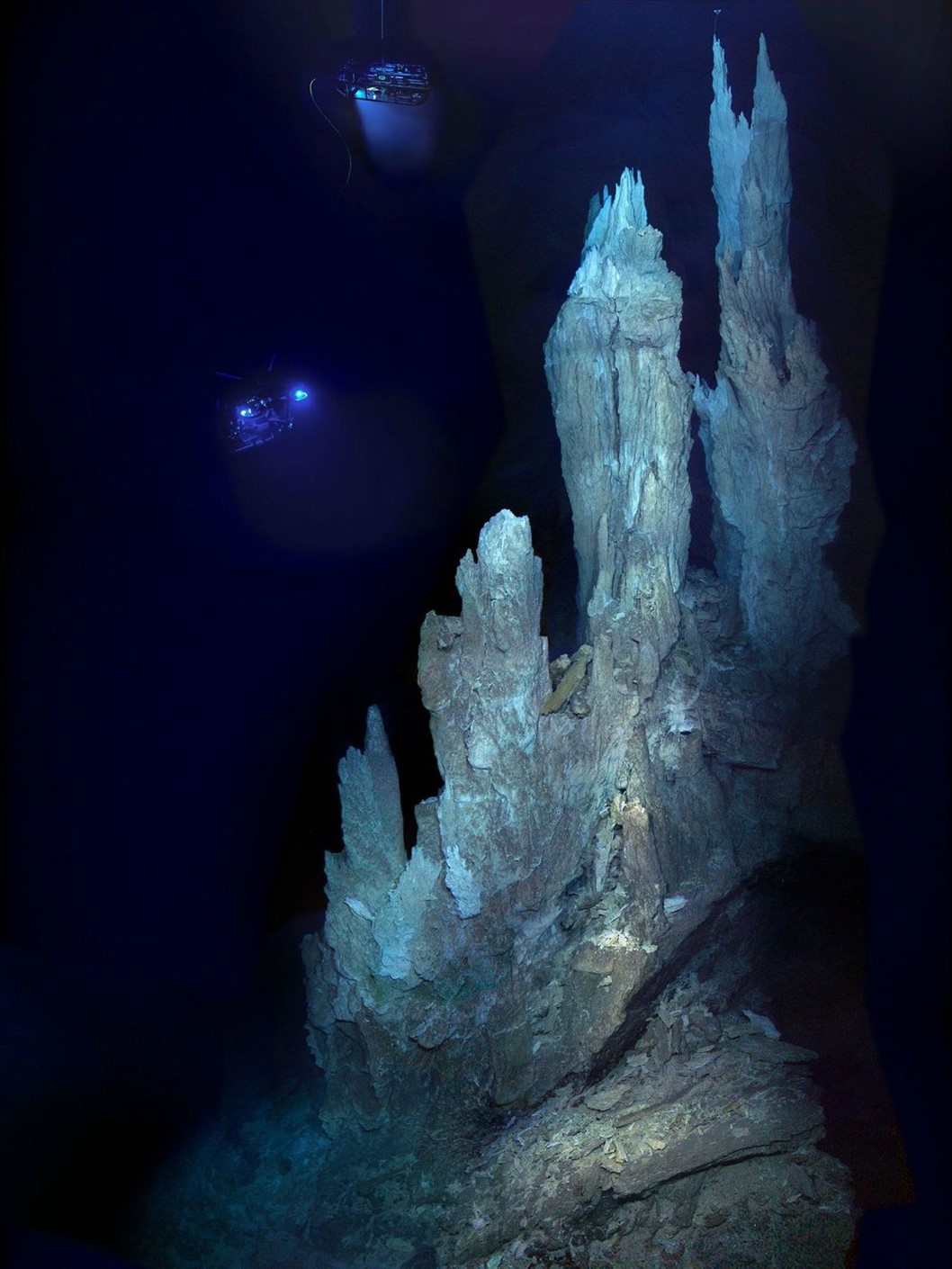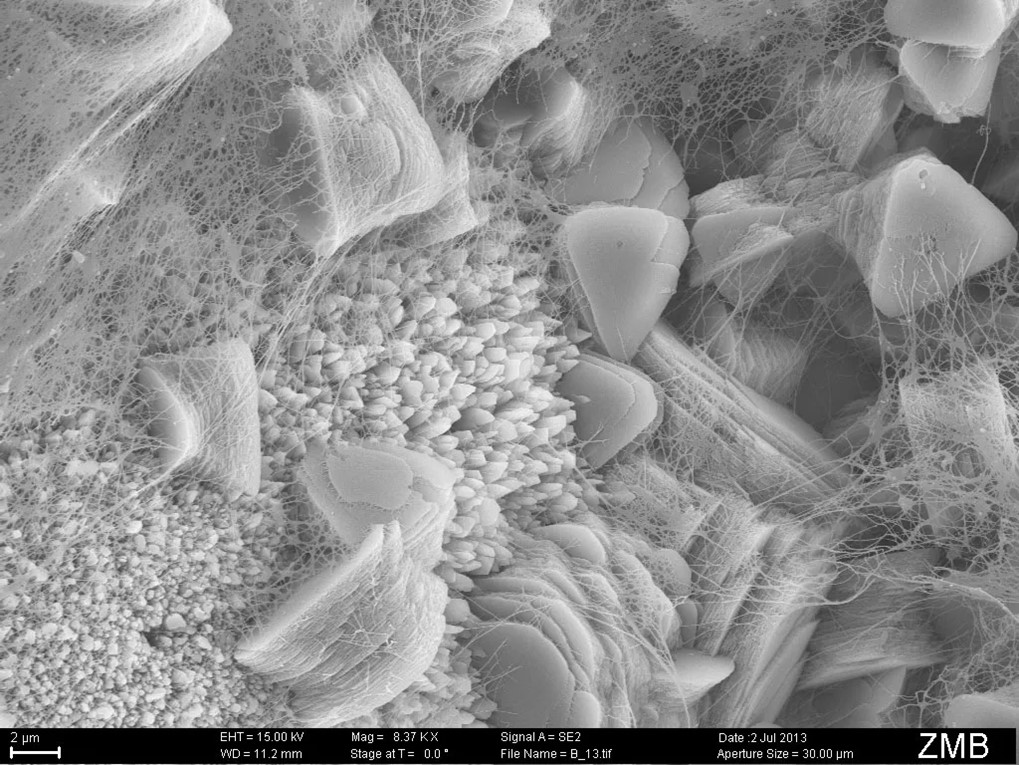
Credit: National Science Foundation (University of Washington/Woods Hole Oceanographic Institution),public domain, via Wikimedia Commons
In the deepest, darkest ocean, caustic, superhot water teems with life.
In the rest of the ocean, the food web is built on photosynthesis. Phytoplankton takes in sunlight and carbon dioxide to give food and oxygen to everything else.
But with no sunlight, these deep ocean communities thrive by chemosynthesis—they consume chemical compounds.
In the 1970s, scientists were amazed to discover previously unknown species of shrimp, clams and tube worms living on so-called black smokers.
These are hydrothermal vents, where water charged with sulfides by volcanic rocks in Earth’s crust comes gushing out at hundreds of degrees.
Specialized bacteria take in volcanic CO2 and convert it directly into organic compounds. These live symbiotically within, or are eaten by, the larger creatures there.
On the Atlantis Massif, discussed in a prior episode, scientists discovered a new kind of chemosynthetic community.
Here, 200-foot-tall white chimneys of calcium carbonate spew near-boiling water that’s almost as alkaline as Drano and rich with hydrogen and methane—which microorganisms within the chimneys have evolved to consume.
Scientists now wonder if dark oceans on other planets or other moons within our solar system, may have hydrothermal vents … which could host their own life forms.
Background
Synopsis: In December 2000, scientists exploring an undersea mountain along the mid-Atlantic Rift suddenly came across an unexpected sight. White structures, some 18 stories tall, with hot, alkaline water pouring out of them. While most hydrothermal vents expel black jets of water, these were different. And they host a unique community of extremophiles that are supported by weathering reactions in mantle rocks. Because they may have a connection to the origins of life, research expeditions have targeted them ever since.
- The legend of Atlantis was invented by Plato around 360 BC, probably as an allegory regarding the gradual corruption of human society in the Greek civilization of his time.
- As the story goes, nine millennia before Plato’s time, the half human–half god citizens of Atlantis created a highly advanced utopian civilization on islands rich with natural resources and wildlife. It became a great naval power.

Athanasius Kircher's 1675 map of Arca Noe, the geography of world after the great flood. The lost island of Atlantis is located in the middle of the Atlantic.
Credit: Athanasius Kircher, public domain, via Wikimedia Commons - But the people became greedy and morally bankrupt, so the gods sank the entire civilization into the sea during a night of fire and earthquakes.;
- Explorers searched in vain for the mysterious island for centuries.
- As the story goes, nine millennia before Plato’s time, the half human–half god citizens of Atlantis created a highly advanced utopian civilization on islands rich with natural resources and wildlife. It became a great naval power.
- With its highest point 2,300 ft (700 m) beneath the sea surface, the Atlantis Massif is not home to any human civilization, but it does host an amazing population of extremophiles supported by its unique geological setting.
- In the previous episode (ED-400 Drilling into Earth’s Mantle), we talked about the formation of this remarkable mountain in the center of the Atlantic Ocean and the 2023 drill hole that sampled Earth’s mantle for the first time.
- First mapped in the late 1970s (ED-286 First Map of the Ocean Floor), the Atlantis Massif is a prominent bulge along the mid-Atlantic Ridge where the ridge takes an abrupt turn along the Atlantis fracture zone.

Location of the Lost City Hydrothermal Field on the Atlantis Massif, on the North Atlantic Ocean floor.
Credit: NOAA Photo Library, public domain, via Wikimedia Commons - The Massif rises about 14,000 ft (4,267 m) from the seafloor and is about 10 mi (16 km) across, making it about the size of Washington State’s Mount Rainier.
- It was named after the legendary civilization because of its location in the middle of the seafloor in the North Atlantic at approximately 30°8′N latitude 42°8′W longitude, near where some seventeenth century maps showed the island of Atlantis.
- It occurs on the north side of the Atlantis Transform Fault, where it intersects with the mid-Atlantic Ridge, offsetting the ridge eastward by about 37 mi (60 km).
- In early December 2000, on an expedition to explore features of the Atlantis Massif, scientists operating a robotic submersible unexpectedly encountered tall white spires sticking up from the summit of the subsea mountain. Nothing like these white features had ever been seen on Earth before.
- The next day, two scientists boarded the DSV Alvin (ED-370 The Longest, Deepest Diver) and descended to the seafloor to get a better look.
- During their five-hour dive they found forests of majestic towering white deposits of carbonate material as much as 200 ft (61 m) tall.

Carbonate chimneys of Lost City imaged during a 2005 expedition to the hydrothermal vent system.
Credit: D. Kelley/ M. Elend/UW/URI-IAO/NOAA/The Lost City Science Team - They measured fluid temperatures as hot as 190°F (88°C) at the vents and collected a few rock samples with evidence of diverse microbial life.
- The Lost City water chemistry is unique. It is alkaline, with a pH of 9 to 12 (like Drano®), and is fairly low in carbon dioxide but rich in hydrogen and methane.
- Back in 1977, scientists aboard the DSV Alvin were surprised to find alien-looking chemosynthetic communities clustered around hydrothermal vents of shimmering hot water flowing out of the seafloor along the Galápagos Rift in the Pacific Ocean.
- Hydrothermal vents like those found along the Galápagos Rift form when cold seawater seeps into cracks and circulates through hot volcanic rocks that are emplaced along oceanic spreading centers all over the globe.
- Temperatures of fluids exiting these chimneys near the Galápagos Rift were as high as 550°F (288°C).
- A couple years later, scientists discovered that in some areas, fluids can heat up to temperatures of as much as 750°F (400°C), leaching minerals and chemicals from the young basalts to form a convection-driven metal sulfide–rich soup that billows out of some of the vents to form “black smokers.”

Black smokers and associated extremophile communities were first discovered in 1979 on the East Pacific Rise at 21°N latitude. Giant tube worms, up to 6 feet long (2 meters) grow in the hot waters emanating from these types of hydrothermal features.
Credit: NASA, public domain, via Wikimedia Commons - The tallest of these dark sulfide towers discovered to date is less than half the height of the white to cream-colored Lost City chimneys.
- These mineralized fluids power ecosystems of highly productive chemosynthetic microbes that consume volcanic carbon dioxide to produce organic compounds.
- The microbes are hosted symbiotically by the unusual clams, tubeworms and other organisms that thrive in the pitch-black environment of deep sea.
- The 1977 discovery of diverse life in the abyss shocked scientists.
- There is no sun, so there is no photosynthesis.
- Just chemosynthesis. It was a different type of life on Earth.
- So, the 2000 discovery of a yet another type of chemosynthetic hydrothermal ecosystem was just as astounding.
- The Lost City hydrothermal vents support a different type of chemosynthetic ecosystem. They emanate from fissures in 1.5 million-year-old mantle material—there is no active volcanism nearby to drive hydrothermal circulation.
- Scientists discovered this hydrothermal activity is generated in a completely different way—by a type of weathering known as serpentinization.
- The mantle peridotites exposed on the Atlantis Massif were formed at very high pressures and temperatures, but once they are exposed by tectonism in the core complex, seawater seeps into them along faults and fractures.
- The peridotites become unstable because they are out of equilibrium with the seawater, so the iron- and magnesium-bearing minerals in the rocks oxidize and hydrate to form serpentinite.
- Serpentinization produces warm (190°F [88°C]) alkaline fluids rich in hydrogen (H2), methane (CH4) and abiotic organic molecules capable of supporting the chemolithotrophic reactions that might support the development of life.

A scanning electron microscope image reveals the wispy biofilms made of microbes on and within Lost City chimneys. This is a much different type of chemosynthetic life than is found near black smokers.
Credit: Courtesy of Tomaso Bontognali, Susan Lang and Gretchen Früh-Green, via Smithsonian Magazine - Convection causes the warm hydrogen- and methane-enriched fluids to bubble out of the seafloor, building the tall white chimneys of calcium carbonate minerals and drawing more seawater into the circulating system.
- The microorganisms at Lost City have adapted to consume the warm, alkaline, hydrogen- and methane-rich fluids to form microbial communities in the interiors of the chimneys with cell densities of 10 to 1,000 cells per cubic centimeter of rock.
- Some microbes produce methane, while others oxidize it to produce energy.
- Since 2000, several expeditions have revisited the Lost City as researchers explore physical and biological processes that were completely unpredicted just 50 years ago.
- Researchers suspect that the serpentinization reaction may have fueled the formation of abiotic compounds that could have been the earliest building blocks for life on Earth.
- Scientists who were amazed by the 1977 discovery that chemosynthetic communities could evolve in hydrothermal volcanic systems are even more astonished at the evolution of a completely different type of chemosynthetic community fostered by a physical process like serpentinization at Lost City.
- Giant tube worms have also been found along cold seeps in the Gulf of Mexico in symbiotic relationships with microbes that use hydrogen sulfide as their source of energy.
- On Earth, life finds a way … or many ways!
- In the universe, vent fields like those observed at Lost City might be analogs for systems that could be present in the deep oceans of icy worlds like Enceladus.

